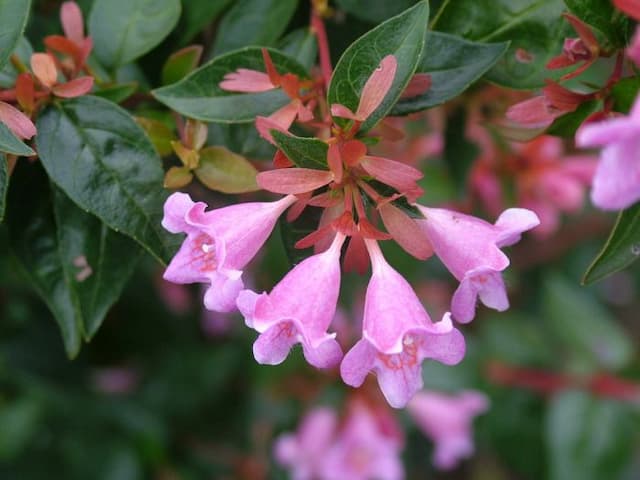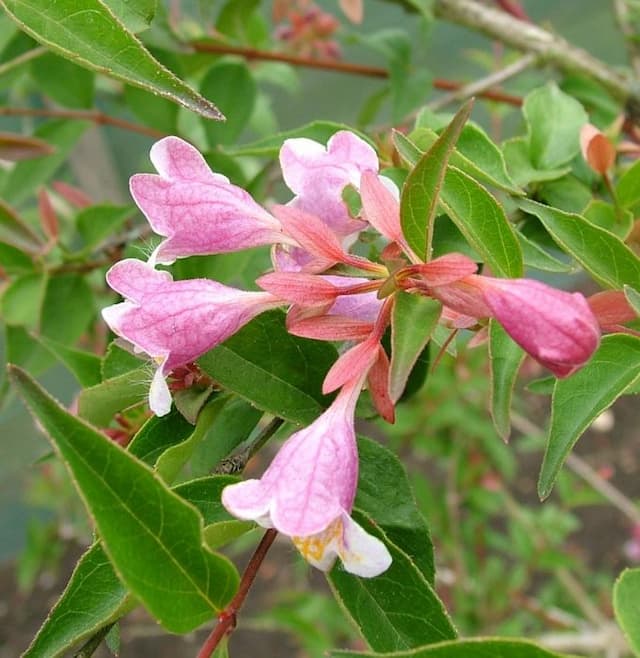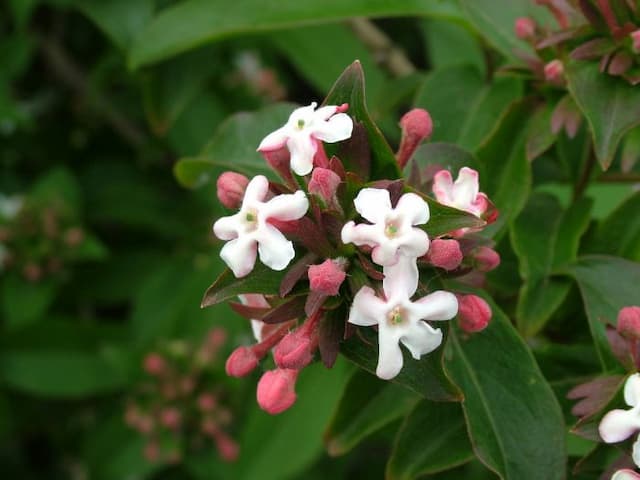Weigela Weigela Ebony and Ivory = 'Velda' (PBR)
![weigela [Ebony and Ivory]](/_next/image?url=https%3A%2F%2Fplants-admin.emdemapps.com%2Fimages%2Fplants%2F%2Fimages%2F604b64b0a2d1c.png&w=3840&q=75)
ABOUT
Weigela Ebony and Ivory, known commonly as Ebony and Ivory Weigela, is an ornamental shrub that boasts a beautiful combination of foliage and blooms. The plant features dark purple to almost black leaves, setting a dramatic backdrop for the flowers. In stark contrast to the foliage, the flowers are trumpet-shaped with a crisp white color, often with a touch of pale pink near the base. These blossoms cluster along the branches and create a striking visual display. The leaves of Ebony and Ivory Weigela are ovate with a slightly serrated edge, giving them a textured appearance. The deep color of the leaves provides a year-round interest, even when the plant is not in bloom. When the flowers appear, typically in late spring to early summer, they create an eye-catching display with their clean white color that illuminates the dark foliage. The overall appearance of this Weigela cultivar is of a lush and contrasting color palette, making it a popular choice for gardeners looking to add a bold statement to their landscape. The plant, being a deciduous shrub, will lose its leaves in the winter, but the dark tones of the branches can still provide visual interest in the bare garden. With its striking colors, Ebony and Ivory Weigela is a showstopper in any garden setting, providing beauty throughout the growing season.
About this plant
 Names
NamesFamily
Caprifoliaceae
Synonyms
Ebony and Ivory Weigela
Common names
Weigela 'Velda' (PBR)
 Toxicity
ToxicityTo humans
Weigela is not commonly known to be toxic to humans. However, as with any plant, individual sensitivity can vary and it's generally advisable to avoid ingesting plant material that is not known to be edible. If Weigela is ingested and symptoms appear, it is recommended to seek medical advice.
To pets
Weigela is generally considered to be non-toxic to pets. However, pets may sometimes have a sensitivity to plants that humans do not, so it is always best to prevent pets from eating plants. If your pet does ingest Weigela and shows any signs of illness, contact your veterinarian.
 Characteristics
CharacteristicsLife cycle
Perennials
Foliage type
Deciduous
Color of leaves
Mixed
Flower color
White
Height
3-4 feet (0.9-1.2 meters)
Spread
3-5 feet (0.9-1.5 meters)
Plant type
Shrub
Hardiness zones
4-8
Native area
East Asia
Benefits
 General Benefits
General Benefits- Attractive Foliage: Weigela Ebony and Ivory features variegated leaves that are green, creamy-white, and sometimes tinged with pink, adding visual interest even when not in bloom.
- Showy Flowers: It produces abundant white flowers with a flush of pink at the base, which can attract pollinators like bees and butterflies.
- Compact Size: 'Velda' is a compact shrub that fits well in small landscapes or garden spaces.
- Seasonal Interest: This Weigela offers a long season of interest with spring bloom time and attractive foliage through summer and fall.
- Low Maintenance: Weigela Ebony and Ivory requires minimal care once established, needing only occasional pruning and watering during drought.
- Drought Tolerant: Once established, it has a degree of drought tolerance, reducing the need for frequent watering.
- Cold Hardy: It has a good tolerance for cold weather, making it suitable for gardens in cooler climates.
- Versatile Landscaping: This plant can be used for border plantings, as a focal point in gardens, or for mass plantings for a dramatic effect.
- Deer Resistant: Typically, it is not favored by deer, which can be an advantage in areas where deer browsing is a problem.
 Medical Properties
Medical PropertiesThis plant is not used for medical purposes.
 Air-purifying Qualities
Air-purifying QualitiesThis plant is not specifically known for air purifying qualities.
 Other Uses
Other Uses- Weigela can be used as a natural dye; its flowers may produce varying shades of pinks and purples for fabrics or other craft materials.
- The plant's dense foliage can serve as a protective habitat for small wildlife, providing shelter and nesting opportunities for birds and beneficial insects.
- Weigela branches can be used in floral arrangements, adding a unique and ornamental touch to bouquets with their dark foliage and contrasting flowers.
- The wood of the Weigela can be harvested and used in the creation of small woodworking projects such as picture frames or decorative carvings.
- Cuttings from Weigela can be used to propagate new plants, which can serve as a hands-on educational tool for gardening workshops or classes.
- The shrub can be shaped into topiary art, making it a creative feature in themed gardens or as a living sculpture.
- Dried Weigela flowers can be used in potpourri mixes, adding fragrance and color to a room when combined with other dried flowers and spices.
- The dense, woody branches can provide the base material for crafting rustic wreaths or other decorative items for the home or special occasions.
- Plant enthusiasts can use Weigela for bonsai, training the tree into miniature forms through careful pruning and shaping.
- Weigela leaves can be included in compost piles, as their nutrient-rich foliage can help to create a balanced compost for garden use.
Interesting Facts
 Feng Shui
Feng ShuiThe Weigela is not used in Feng Shui practice.
 Zodiac Sign Compitability
Zodiac Sign CompitabilityThe Weigela is not used in astrology practice.
 Plant Symbolism
Plant Symbolism- Contrast: The 'Ebony and Ivory' Weigela, with its distinctive dark foliage and white flowers, can symbolize the beauty and harmony of contrasts coming together.
- Duality: This plant can represent the concept of duality — the pairing of opposites — much like its two-toned name suggests.
- Elegance: Its sophisticated color combination may symbolize elegance and a refined aesthetic sense.
- Unity: The blending of ebony (black) and ivory (white) in one plant could symbolize unity and the peaceful coexistence of different elements.
- Balance: With its evenly matched colors, the Ebony and Ivory Weigela can symbolize balance, suggesting that opposites can create a harmonious whole.
 Water
WaterThe Ebony and Ivory Weigela should be watered deeply so the water reaches the roots, about once a week, depending on weather conditions. During hot and dry periods, it may require watering two or three times per week to maintain soil moisture. Ensure that the plant receives approximately 1 gallon of water at each watering session if it's a new planting, increasing to 2 gallons as the plant establishes. In the case of established plants, they can be watered every other week with up to 2 gallons per session, reducing frequency if there has been significant rainfall.
 Light
LightThe Ebony and Ivory Weigela thrives in full sun, meaning it should receive at least 6 hours of direct sunlight per day. An ideal spot is a south-facing location where it can bask in bright and sunny conditions. While it can also tolerate partial shade, flowering may not be as prolific compared to when planted in full sun exposure.
 Temperature
TemperatureThe Ebony and Ivory Weigela prefers a temperate climate and is cold hardy in temperatures as low as 20 degrees Fahrenheit. Its ideal growing temperatures range from 60 to 75 degrees Fahrenheit but can survive up to high temperatures around 90 degrees Fahrenheit. It is vital to protect the plant from extreme frosts below 20 degrees Fahrenheit, which could damage or kill it.
 Pruning
PruningPrune the Ebony and Ivory Weigela immediately after it finishes blooming, typically in late spring or early summer, to shape the plant and encourage new flower bud formation for the next year. Cut back about one-third of the oldest stems to the ground to rejuvenate the plant. Pruning is essential for promoting a healthy, full, and flowering Weigela and is best done annually.
 Cleaning
CleaningAs needed
 Soil
SoilWeigela Ebony and Ivory prefers well-draining soil enriched with organic matter; a mix of loam, compost and coarse sand is ideal. It thrives best in a soil pH ranging from slightly acidic to neutral (5.5 to 7.0).
 Repotting
RepottingWeigelas, including Weigela Ebony and Ivory, are typically grown in the ground and do not often require repotting. When grown in containers, repot every 2-3 years to refresh the soil.
 Humidity & Misting
Humidity & MistingWeigela Ebony and Ivory tolerates average outdoor humidity levels well and does not require any special humidity considerations when planted in its appropriate hardiness zones.
 Suitable locations
Suitable locationsIndoor
Not ideal for indoor growing; needs full sun.
Outdoor
Plant in full sun, well-drained soil, fertilize annually.
Hardiness zone
4-8 USDA
 Life cycle
Life cycleThe Weigela 'Ebony and Ivory' begins its life cycle as a seed, which, upon germinating in favorable conditions of soil, light, and moisture, develops into a seedling. The plant enters a vegetative growth stage, where it focuses on producing leaves and stems, gradually forming a bushy shrub. After maturation, which can take several years, the Weigela 'Ebony and Ivory' progresses to the reproductive stage, characterized by the flowering of white blooms with yellow throats against dark burgundy leaves, typically in late spring to early summer. Following pollination, often aided by insects, the plant produces small fruit containing seeds, completing the reproductive cycle. As a perennial shrub, it enters a period of dormancy in the fall and winter, where growth slows down or stops as the plant conserves energy. With the onset of warmer weather in spring, the cycle repeats with new growth and another flowering season.
 Propogation
PropogationPropogation time
Spring-Early Summer
The Weigela Ebony and Ivory, also known as 'Velda', is commonly propagated through softwood cuttings. This is typically done in late spring or early summer when new growth is still flexible. To propagate by cuttings, a 4 to 6 inch (10 to 15 centimeters) long cutting should be taken from a healthy stem, ensuring at least two to three leaves are present. The lower leaves are removed and the cut end is dipped in rooting hormone to encourage root development. The cutting is then planted in a well-draining soil mix and kept in a humid environment with indirect light until roots have established, which generally takes a few weeks. The new plant should be kept well-watered and out of direct sunlight until it has grown sufficiently to be transplanted to a more permanent location.








![Himalayan honeysuckle [Golden Lanterns]](/_next/image?url=https%3A%2F%2Fplants-admin.emdemapps.com%2Fimages%2Fplants%2F%2Fimages%2F604b55302cc87.png&w=640&q=75)
